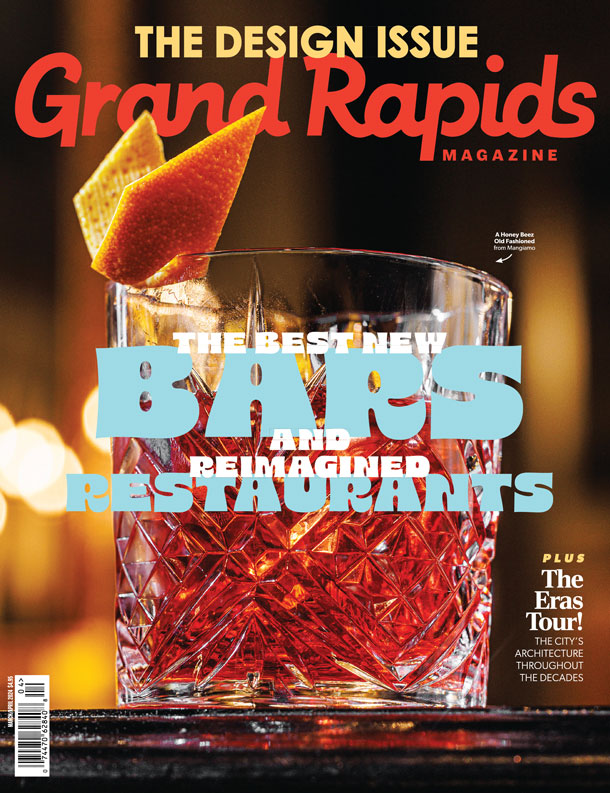One of my favorite breweries in the area is Cedar Springs Brewing Co.
I have a soft spot for German food and an even larger soft spot for German beer. The subtle nuances in the often simple beers create extraordinary amounts of accessible flavor, so even the people who might scoff at craft beer for being overly bitter are likely able to find a beer they like.
I’ve already chatted with owner David Ringler this year for Drinks with Pat, but I figured with his Grand Rapids location, Küsterer Brauhaus, opening next week, we’d give it another go. He’s always a good chat, a big lover of history, hence the name of the new location.
Also, if you’re curious about the namesake of the place, Christoph Küsterer, check out my book, Grand Rapids Beer (I’ll never let an opportunity to promote my book slip by).
This conversation was edited for clarity.
Pat: So before we get into the new spot, I’m just curious, and I guess the craft movement was against accessible mass-produced beers, but I love your Küsterer line of beers, why go with a German slant?
David: Short answer first: I fell in love. I started my brewing career in Germany, and I just fell in love with the culture and some of those styles. And I’m like, this just isn’t available in my home. I wanted to share some of that culture that I fell in love with at home, and so we just made the commitment to focus on these traditional styles of drinking beer, making beer that your great-great-grandfather drank, and they’ve been around for centuries.
And we’ve just taken pride in upholding those traditions and trying to do them as well as we can. We’ve been, frankly, thrilled at the response and some of the national and international awards we’ve garnered.
The long answer is the industry’s always been that way. If you think of the late ‘90s, every tap room you went into, they usually were small. They had four or five beers, and they had a light, a light ale, an amber ale, a dark ale and maybe a hoppy one. … Now you have fruit beers being labeled IPA, whether it is or it isn’t.
You’ve had movements and the national industry trying to push people to pilsners and lagers the last few years. I don’t know how much consumers really consume. And if you look nationally, I mean, they say IPA leads, but quite honestly, the best selling crafty beers are wheat beers.
It’s Blue Moon, it’s Shock Top, but they’re approachable. They can be complex, but they can also be easy to drink. So we just found a little magic and tried to recreate some of that atmosphere and ambiance of, like I said, a lovely culture that I fell in love with.
We have our niche, and we’re sticking with it. And, quite honestly, I have to give credit to (Brewery Vivant’s) Jason’s Spalding, who I’ve known for years and years, but it was funny when I sat down with him, when I was thinking about quitting, leaving my previous industry, where I’d had some success and saying, this is really what I want to do. I was thinking about different styles, and he’s like, “Well, I would just challenge you to do what you do.” And so that’s kind of what we did.
Pat: German beer is so simple, but has such a wide array of flavors, how do you help people wrap their heads around that?
David: That’s one of the keys of German-style beer. First of all, it’s four ingredients.
The Germans obviously have been doing this for a long time, and part of the magic of what they do when you get into the brewing side is you’re really trying to create subtlety.
That’s a non-American thing, because we tend to hit people in head with a two-by-four of flavor. And that’s the reason IPAs here went from Burton-on-Trent to a California triple IPA that is, you know, 120 IBUs
Editor’s note: IBU stands for international bitterness unit, and at 120 … it’ll basically burn your tongue.
But with these, you can sit down with a wheat beer, and you can say there are little hints of clove, or is that banana or nut? There’s a little nutmeg in there. … And it pairs up with this dish, and you can also just sit there and have a couple of beers with friends and not give it a second thought.
They are drinkable by definition, and they are meant to accompany social experiences and the cuisine that region is known for and the way those beer halls have developed, just like what we’ve done here is to foster that communal sense.
It’s been cool in these practice sessions that we’re getting people sitting together that don’t necessarily know each other, and they’re sitting down at the same table, and they’re striking up a conversation. We’re just doing that and lubricating it a little bit.
Editor’s Note: It was a nice long convo with David, so I’ll save the rest for the November/December print issue of the magazine. But it was neat to learn he’s met descendants of Mr. Küsterer, a once prominent businessman in Grand Rapids (again, read my book), who died in a shipwreck on Lake Michigan.
What’s Pat drinking
Recently we chatted with Waterford Distillery about terroir in whiskey. That was cool. Well, the same guy who started that is doing the same with rum. Renegade Rum is meant to showcase terroir in the sugar-cane based spirit. Pretty cool stuff!
Second, I’ll be sipping on Boulevardiers this weekend. It’s like a Negroni, the gin-based, bitter cocktail I detailed last week. But now, this week, we’ll spin it by replacing the gin with a nice rye whiskey — try something like Templeton or Whistlepig, or your favorite rye whiskey.
Boulevardier
1.5 ounces of rye whiskey or bourbon
1 ounce of sweet vermouth
1 ounce Campari
Method: Pour ingredients into mixing glass. Fill with ice and stir. Strain into cocktail glass (you can serve on the rocks if desired). Garnish with an orange twist or a cherry. I personally like to twist it up with two cocktail cherries and a bit of the syrup.








Facebook Comments